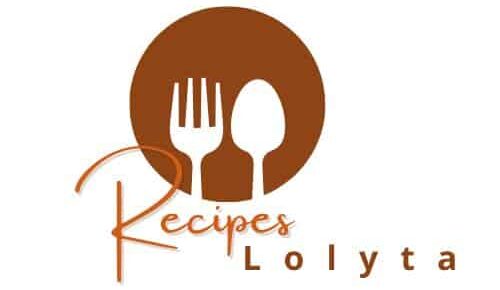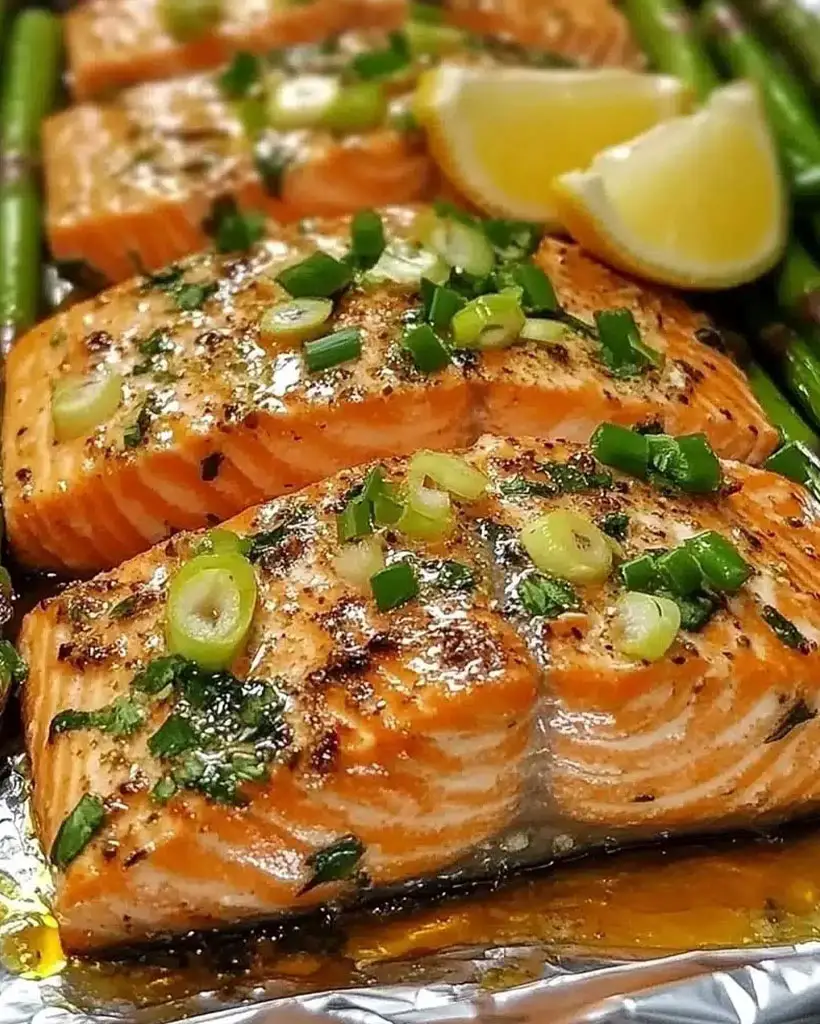Baked Salmon in Foil: A Flavorful Dining Experience
Imagine a delightful meal that’s not only tasty but also packed with nutrition. This Baked Salmon in Foil with Asparagus is an epitome of culinary art that combines freshness with simplicity. As the salmon bakes, it releases its flavorful juices, merging with the fresh essence of asparagus, creating a symphony of tastes on your palate. For seafood lovers looking to experience an easy yet sophisticated dish, this salmon recipe promises an enticing experience with every bite.
Serving Baked Salmon in Foil encourages a minimalist approach to cooking, emphasizing natural flavors and the innate textures of the ingredients. The convenience of baking in foil ensures even cooking, capturing the delicate aroma of fresh herbs and the tang of lemon. As you unwrap the foil, be greeted by a wave of fragrant steam that perfectly encapsulates the rich scent of baked salmon with vibrant green asparagus. This harmonious blend not only pleases the eyes but also fills the room with an inviting aroma that’s hard to resist.
Quick Recipe Highlights
Flavor Profile: Enjoy the marriage of buttery salmon with a hint of lemon zest and fresh asparagus. Each bite reveals a balance of savory and tangy notes that elevate the salmon’s natural sweetness.
Texture: The salmon is tender and flaky, while the asparagus retains a slight crispiness, resulting in a satisfying textural contrast that enhances the eating experience.
Aroma: The fresh scent of dill and lemon complements the rich aroma of salmon, delivering an olfactory delight that stimulates the senses before you’ve even taken a bite.
Visual Appeal: Bright, vibrant green asparagus beautifully contrasts with the pinkish hue of salmon, making for a visually appealing presentation that looks as good as it tastes.
Skill Level Needed: This recipe is beginner-friendly, requiring no advanced culinary skills. It’s perfect for those new to cooking or anyone looking for a simple, foolproof dish that’s sure to impress.
Special Equipment: With just a baking sheet and foil, you can effortlessly prepare this dish. No special kitchen gadgets are necessary, which makes the cooking process seamless and hassle-free.
Recipe Overview
Difficulty Level: This recipe is categorized as easy due to its straightforward steps and minimal ingredient list. It involves wrapping salmon and vegetables in foil and baking, making it accessible for all home cooks. Even those new to the kitchen can achieve great results with this method, which simplifies cooking and requires little hands-on time.
Category: Baked Salmon in Foil with Asparagus is a main course, making it ideal for lunch or dinner. It’s light yet fulfilling, which categorizes it as a healthy, everyday meal option that doesn’t shy away from flavor or nutrition.
Cuisine: This dish draws on Mediterranean influences where fresh, simple ingredients come together. The use of olive oil, lemon, and herbs is typical of Mediterranean flavors, emphasizing health and fresh produce.
Cost: Compared to dining out, preparing this dish at home is cost-effective. The primary expenses come from purchasing fresh salmon and asparagus, both of which are fairly reasonable in price, yielding a gourmet dish at a fraction of restaurant prices.
Season: While this meal can be enjoyed year-round, it shines in spring and summer when asparagus is in season. This ensures the freshest, most tender stalks that add a delightful crunch and vibrant color.
Occasion: Whether you’re hosting a relaxed family dinner or a special occasion, this recipe is versatile. Its elegant presentation makes it suitable for laid-back gatherings as well as festive celebrations.
Why You’ll Love This Recipe
The taste and texture of this Baked Salmon in Foil are truly outstanding. The salmon is juicy and flavorful, complemented by the tender-crisp asparagus. Whether you’re seeking a nutritious option or a dish that embodies simplicity and elegance, this recipe satisfies both demands effortlessly. The combination of lemon, dill, and garlic enhances the flavors without overpowering the natural taste of the salmon. It’s an effortless masterpiece that’s sure to become a staple in your weekly meal rotation.
Convenience is another major plus point. Requiring minimal preparation, this recipe allows you to pop the salmon and asparagus into the oven and walk away. This hands-off approach is perfect for busy weeknights when you crave a delicious home-cooked meal without the fuss. The aluminum foil not only facilitates even cooking but also makes cleanup a breeze, leaving you more time to enjoy dinner and less time scrubbing pots and pans.
Nutritional benefits abound in this dish. Salmon is a well-known powerhouse of omega-3 fatty acids, essential for heart health, while asparagus offers a wealth of vitamins, minerals, and antioxidants. This makes the dish not only delicious but also a wise choice for those looking to nurture their bodies with wholesome food. It’s a delightful way to incorporate more fish and vegetables into your diet without sacrificing flavor.
In terms of social and entertaining value, serving Baked Salmon in Foil positions you as a gracious host who cares about their guests’ palates and health. The presentation is professional without any of the stress, making it an ideal dish for when you want to impress without spending all day in the kitchen. Guests will be delighted by the tantalizing aromas and beautiful colors when they are served this tasty salmon dish.
Lastly, it’s cost-effective and accessible. Most of the ingredients are pantry staples or readily available at local grocery stores. Even if you decide to use organic or premium ingredients, the overall cost remains reasonable, particularly given the flavors and quality you achieve. It’s a luxury meal experience that doesn’t break the bank and can often be made with what you have on hand.
Historical Background and Cultural Significance
The origins of baking fish in foil date back to European culinary traditions where cooking en papillote (French for “in parchment”) was a popular technique to cook fish. Although parchment was traditionally used, foil has become a modern substitute due to its availability and ease of use. This method seals in moisture and flavors, resulting in tender and aromatic outcomes that have appealed to generations.
Culturally, baked fish dishes hold a significant place at the Mediterranean table, where the emphasis is on fresh ingredients. Salmon in foil aligns with this tradition, highlighting the importance of using high-quality, fresh produce and simple cooking techniques. This ensures that flavors are not masked by heavy sauces but rather enhanced, celebrating the main ingredient—salmon.
Over time, the recipe has evolved. What started as a method for retaining moisture and texture in fish has become a versatile cooking practice. Various herbs, aromatics, and vegetables are now incorporated to cater to different taste preferences, cultural tastes, and dietary needs. This evolution underlines the beauty of fusion cooking, where ancient methods meet contemporary tastes.
Regional variations abound, with countless adaptations in different parts of the world. While Mediterranean versions may prefer olive oil and herbs, Asian interpretations might involve soy sauce and ginger. In contrast, North American recipes often feature maple syrup or brown sugar glazes. These adaptations reflect cultural tastes and available ingredients, adding layers of complexity and heritage stories to this dish.
Ingredient Deep Dive
Salmon is revered globally for its rich taste and numerous health benefits. It holds a special place historically in many indigenous diets, especially amongst Pacific Northwest tribes where it was, and remains, a dietary staple. Its cultural significance is showcased in folklore and traditional festivities, where salmon symbolizes life and sustenance.
Nutritionally, salmon is a standout. It’s rich in omega-3 fatty acids, which are beneficial for cardiovascular health, inflammation reduction, and cognitive function. Additionally, salmon provides ample protein, essential vitamins like B12 and D, and minerals such as selenium. These nutrients support bone health, improve skin elasticity, and enhance mood.
Selecting the best salmon involves choosing fish with bright, firm flesh and a mild scent. Wild-caught salmon is often preferred for its environmental sustainability and better nutrient profile compared to farmed varieties. Fresh salmon should be stored wrapped loosely in plastic or butcher paper in the coldest part of your refrigerator and consumed within two days of purchase.
For the Asparagus, this spring vegetable has a rich history, dating back to ancient Egypt, where its rapid growth and unique flavor were highly prized. Enjoyed in a variety of cuisines today, asparagus remains a symbol of spring and renewal, cherished for its texture and ease of cooking.
Nutritionally, asparagus is low in calories but rich in fiber, vitamins A, C, and K, and minerals such as folate and potassium. It’s praised for its antioxidant properties, supporting healthy digestion, reducing bloating, and enhancing the immune system. It’s easy to prepare and cook, making it a favorite in health-conscious kitchens.
When selecting asparagus, choose bright green stalks with tightly closed tips. The thickness of the stalks can vary, but they should snap easily when bent. Store asparagus in the refrigerator, with the tips wrapped in a damp paper towel to maintain freshness. To extend its shelf life, consider storing asparagus in a glass of water, similar to flowers, and covering the stalks with a plastic bag.
Common Mistakes to Avoid
Oversalting can easily overpower the natural flavors of this dish. Use salt sparingly as both salmon and asparagus have their inherent tastes that shine when not masked.
Overcooking salmon is a common pitfall. When baked too long, the fish can become dry and lose its tender quality. Keep an eye on cooking times to maintain its succulent texture.
Failing to seal the foil packet properly may result in steam escaping, which can lead to uneven cooking. Ensure the edges are sealed tightly to trap heat and flavors effectively.
Using low-quality foil may result in tearing and cause you to lose those precious juices. Invest in a good-grade foil to avoid mishaps and create a reliable steam pocket.
Insufficient seasoning is a missed opportunity to enhance the dish’s flavor. While you don’t want to overpower, using herbs, lemon, and a touch of pepper can make a huge difference.
Overcrowding the packet can hinder even cooking. Ensure the pieces of asparagus and salmon are arranged in a single layer to allow for proper heat distribution.
Forgetting to preheat the oven could lead to improper cooking temperatures, affecting the texture of both salmon and asparagus. Always preheat to the specified temperature.
Skipping olive oil can cause asparagus to dry out. A drizzle enhances flavor and assists in transferring heat evenly, so it roasts instead of steams.
Essential Techniques
Properly wrapping the foil packet is crucial for this recipe’s success. This technique traps steam, encouraging even cooking and maintaining moisture within the salmon and asparagus. Ensure the packet is tightly sealed to prevent it from opening during baking.
Baking in foil is significant for creating a moist environment that enhances the flavors of the ingredients. Mastering this technique involves ensuring an even distribution of vegetables and salmon in the packet for consistent cooking.
Monitoring cooking times is vital to avoid dry or undercooked salmon. Most filets reach the optimal texture between 15-20 minutes. Visual cues like the salmon’s flakiness can guide you on its doneness.
Presentation starts with properly laying out ingredients inside the foil. Ensuring that asparagus tips aren’t covered by the salmon allows them to roast and retain their natural crunch, while lemon rounds should be placed on top for infusion.
Pro Tips for Perfect Baked Salmon in Foil
Choose the right asparagus stalks. Thicker stalks typically roast better alongside salmon as they stay crisp without overcooking. Thinner stalks can be added a few minutes into baking to avoid overcooking.
Don’t skip the rest period! Allow the baked packet to sit for a couple of minutes before serving. This step lets the juices redistribute evenly, enhancing flavor distribution in the salmon.
Try infusing flavory herbs like thyme or rosemary into the packet. They add a fresh aromatic note and elevate the overall taste profile, giving your salmon and asparagus a distinctive twist.
Opt for wild-caught salmon for its richer flavor and firmer texture. Its taste is superior, and it bakes beautifully within the foil, while its richer color adds to the meal’s visual appeal.
Layer lemon slices beneath and atop the salmon. This ensures that the citrus flavor permeates the fish, offering brightness that contrasts the savory depth of the salmon’s natural oils.
Consider adding a splash of white wine into the packet before baking. It enhances the moisture content and infuses a nuanced depth that takes this dish to gourmet levels effortlessly.
For an added crunch and flavor boost, sprinkle sliced almonds or sesame seeds over the asparagus before baking. It creates a delightful texture contrast with the soft fish and tender vegetable.
Double-up aluminum foil if necessary to prevent leaks. While costly spills may not occur often, reinforcing the packet lends a reassuring guarantee against accidental rips or tears during cooking.
Variations and Adaptations
Regional variations offer exciting ways to adapt this dish. Incorporate Asian flavors by using a soy-based marinade with ginger and sesame. Alternatively, try a Middle Eastern version with sumac, fresh mint, and a touch of harissa for heat.
Seasonal adaptations are easily implemented. During autumn, swap asparagus for Brussels sprouts or broccoli, both of which similarly benefit from the roasting process, complementing the salmon’s baked texture.
For dietary modifications like gluten-free adaptations, ensure ingredients like sauces or added condiments are certified as gluten-free. Luckily, this recipe naturally bypasses many allergy concerns by focusing on whole foods.
Flavor variations are endless with different herbs and aromatics. Use dill in place of thyme, or incorporate garlic for additional depth. Fresh orange zest or shallots can provide a new flavor profile without altering the foundational recipe.
Consider texture modifications by adding a layer of creamy ricotta under the salmon. Its mild flavor pairs well, introducing a luxurious mouthfeel that contrasts nicely with the flakiness of the fish.
Presentation alternatives might involve using parchment paper instead of foil for an eco-friendly option. It yields equally flavorful results, while producing an elegant aesthetic when plated.
Serving and Presentation Guide
Utilize plating techniques like layering asparagus with salmon artfully on top, garnished with freshly chopped parsley or dill. Leave the foil intact for dramatic unwrapping directly at the table, releasing aromatic steam upon presentation.
Garnishing ideas include sprigs of fresh herbs such as thyme or rosemary placed atop for a stunning visual effect, along with a drizzle of extra virgin olive oil to add a shine just before serving.
Traditional accompaniments to consider are new potatoes or a spring salad of arugula. They round out the meal with earthy notes and refreshing brightness, complementing the main flavors beautifully.
Modern serving suggestions might include quinoa salad for a twist or lemony couscous as a side. These options create trendy, balanced meals with added nutritional benefits.
Temperature considerations dictate serving this dish warm, but not hot, to ensure optimal enjoyment and gentle flaking of salmon. But if served cold, it takes on a delightful, more robust flavor for a picnic or buffet setting.
Portion control tips include measuring salmon fillets to about 100-150 grams per serving, allowing nutritious balance without overindulgence, and providing satisfactory portions to accompany other chosen sides.
Wine and Beverage Pairing
Wine pairings enhance the flavors of Baked Salmon in Foil. Opt for a crisp white like Sauvignon Blanc or a medium-bodied Chardonnay. These wines’ acidity balances salmon’s richness and complements lemon-zestiness and herbaceous notes.
Non-alcoholic alternatives can include a refreshing citrus-infused water or sparkling apple cider. Both provide effervescence and an acidity that mirrors the palate-cleaning attributes of wine.
Consider coffee or tea pairings for brunch gatherings. A lightly steeped white tea with its floral notes makes an unexpected but delightful combination with the savory salmon and fresh asparagus.
Temperature considerations for beverages play a role in enjoying the dish to its fullest. Cool drinks refreshingly contrast the warm, savory elements, adding another sensory layer of satisfaction.
Serving suggestions for beverages involve presenting them in a chilled vessel or with an ice bucket nearby to maintain desired temperatures, keeping drinks crisp and revitalizing throughout the meal.
Storage and Shelf Life
Proper storage starts with ensuring leftover salmon is cooled completely before transferring to airtight containers. Place a wax paper between layers if stacking slices to avoid sticking.
Temperature requirements include refrigeration below 4°C (40°F). Consume leftovers within 3 days to enjoy optimal flavor and texture, being mindful of fish spoilage risks.
Container recommendations involve using glass or BPA-free plastic to avoid any residual food smells from spoiling fresh ingredients, and these containers are best fitted with tight seals.
Signs of spoilage entail changes in color, off-putting fishy odors, or slimy surface texture. At the first indication of spoilage, it’s better to err on safety and discard the dish.
Reheating instructions suggest using a low oven temperature, around 150°C (300°F), to gently warm the salmon. Avoid microwaving as it can lead to drying and rubbery texture.
Freezing guidelines advise pre-freezing on a sheet tray before sealing in a zip-top freezer bag to avoid clumping. Thaw overnight in the fridge, reheating as needed for later enjoyment.
Make Ahead Strategies
Prep timeline is simplified by chopping asparagus and preparing lemon-herb salad dressing in the morning or a day ahead to minimize last-minute tasks, allowing for ease of assembly later.
Storage between steps can maintain freshness. Keep prepped ingredients separate to preserve texture and avoid premature wilting or mixing of flavors, creating the ideal conditions for uniform results.
Quality impact assessment ensures maintaining original flavors is possible by prepping certain elements aside, such as sauces or garnish, just before serving to retain vivid colors and ultimate freshness.
Assembly tips suggest keeping everything consistent when placing ingredients in packets. Even spacing ensures proper conduction, averting overcooked sections and uneven seasoning distribution.
Reheating guidelines point to gently warming salmon at 150°C (300°F) in the oven once assembled but consume within 24 hours for gains on both quality and flavor retention.
Fresh element additions like a last-minute splash of citrus elevates the dish on second serving, ensuring vibrancy and reinvigorating flavors to present as though newly assembled.
Scaling Instructions
Halving the recipe involves reducing ingredient quantities proportionally, simplifying preparation without altering cooking times. It’s ideal for meals with fewer guests, maintaining flavor integrity.
Doubling or tripling necessitates ensuring adequate space for even cooking. Scaling up works best with multiple foil packets, maintaining similar cooking times for consistency without overcrowding the oven.
Equipment adjustments include employing a larger baking sheet or multiple oven racks to accommodate increased quantities, promoting airflow and ensuring even broiling capabilities.
Timing modifications remain steady when scaling as the sealed cooking environment preserves harmony in baking across packeted contents, resulting in similar desirable textures.
Storage considerations ensure larger volumes need individual attention when cooling before refrigerating in airtight containers, maintaining the same care for recognizing spoilage.
Nutritional Deep Dive
Analyzing nutritional value reveals this dish’s macro breakdown: primarily protein-dense due to salmon (source of essential fatty acids) and fibrous asparagus, providing a congruent nutritional profile.
Micronutrient analysis highlights vitamin D and omega-3-rich fish benefits, while vitamin A, C, and K from asparagus enhance bone health, immunity, and cellular repair – offering a complete nutritional package.
Health benefits impart balance, promoting cardiovascular wellness from salmon’s healthy fats and aiding with proper digestion and skin health through asparagus, based on nutritional data from USDA sources.
Dietary considerations involve accommodating gluten-free and paleo-friendly preferences without sacrificing flavor by retaining core ingredients yet allowing customized modifications suiting different regimens.
Portion analysis indicates each serving size may vary per individual caloric needs but offers significant portions for adults seeking daily nutrient requirements or adjusting according to specific health goals.
Weight management tips leverage dish simplicity and fullness from fibrous elements combined with satiating protein to encourage portion control and mindful eating strategies easily followed.
Dietary Adaptations
To accommodate gluten-free needs, ensure all accessory ingredients like condiments remain free of gluten derivatives. The core recipe itself, however, is inherently gluten-less, avoiding problematic ingredients.
Dairy-free alterations can be achieved, as no dairy is present unless garnished with a topping such as cheese, which can be omitted or replaced with vegan alternatives if desired.
For vegan adaptations, swap salmon with tofu or portobello mushrooms, combined with revised seasonings that complement plant-based equivalents, transforming the dish effortlessly into a meatless variant.
Low-carb dieters are well-suited to this meal’s naturally low carbohydrate content, assigned to high protein from salmon accompanied by fiberful green asparagus conducive for ketogenic lifestyles.
Keto transformations align easily with core factors retaining high-fat influences through oily fish consumption and additional healthy fats enriched by olive oil used in preparation.
Paleo diets naturally embrace dairy and gluten freedom of the original recipe, aligning well within paleo constructs while accounting for potential adjustments preferring ancestral food sources.
Low-FODMAP adjustments are achievable by refraining from high FODMAP inclusions like garlic, substituting other flavors (i.e., infused oils) aligned better to Low-FODMAP compliant smart swaps.
Other specific diets, depending on personal requisites, can derive benefit through strategic alterations, embracing preferences while remaining faithful to essential flavor profiles inherent to Baked Salmon in Foil.
Troubleshooting Guide
Addressing texture issues involves confirming exact cooking times to shield salmon from drying and promoting pliable, juicy results. Ensure packet sealing is strict to encompass consistent moisture.
Flavor balance is remedied by a balanced marinade or seasoning approach. Excess salt can overshadow flavors, therefore begin conservatively and adjust herbs or citrus for balance when required.
Temperature problems necessitate oven thermometers ensuring calibrations hold steady to avert fluctuating temps impacting cooking times, preserving original flavor and texture constructs.
Equipment challenges arise without foil. Opt for parchment adaptation or oven-safe bakeware solutions cushioning with a content-appropriate lid to maintain similar results.
Ingredient substitutions like switching from dill to thyme or other herbs offer potential recovery where conventional selections may not be obtainable. Determine equivalents able to retain core flavors.
Timing concerns are addressed by evaluating prep sequences for multi-task efficiency, reducing missteps arising from time miscalculations leading to overextended cooking or burnt elements.
Recipe Success Stories
Community feedback often shows success in variations incorporating different herbs and spices, playing according to taste preferences varying by region, delivering wide satisfaction with consistent outcomes.
Variation successes may spotlight simple ingredient substitutions reaping unique versions without diminishing overarching recipe structure, fostering personal creativity in traditional applications.
Adaptation stories unfold through reader shared innovations promoting various cultural twists, whetting a diverse audience palate through exploration unknown extras warranting enthusiastic testing.
Reader suggestions featured countless experiments leading to delightful flavor combinations or techniques unearthed through collaboration and dialogue, inviting ongoing recipe refinement.
Photography tips to accentuate dish’s appeal suggest natural lighting maximizing color vibrancy exhibited by the pearl-white salmon flesh flanked by vivid greens set against foil presented visually strikingly.
Frequently Asked Questions
How do I know when the salmon is done? The salmon should be opaque and flaky when tested with a fork. An internal temperature of 63°C (145°F) indicates readiness for eating.
Can I use different vegetables? Absolutely! Feel free to incorporate alternatives like cherry tomatoes, bell peppers, or baby carrots that can withstand similar roasting times as asparagus.
Is this dish healthy? Yes. It’s high in protein, fiber, vitamins, and essential fatty acids; conducive to balanced nutrition associated with heart and overall wellness.
Do I have to use foil? While foil ensures optimal baking results, parchment paper is viable for eco-conscious alternatives, offering an equally satisfying baking outcome with proper wrapping technique.
Can I freeze leftovers? Certainly. Allow any remaining portions to cool, wrapping them securely in airtight packaging before freezing. Consume within 3 months for best-flavor retention.
Is dill necessary for taste? While it adds distinct flavors complementing salmon, replacing it with suitable herbs (tarragon or basil) bears equally delightful enhancements, contingently altering subtleties.
How do I prevent foil from sticking? Lightly oil both sides prevents any sticking and creates a non-stick surface improving overall ease upon the baked items’ unveiling during meal presentation.
What wine works best with this dish? A light Sauvignon Blanc or moderate Chardonnay perfectly aligning with lemon zest and providing contrasting profiles pairing beautifully with savory fish notes.
Is fresh salmon crucial, or can I use frozen? Both fresh and frozen serve exceptionally. Thaw frozen salmon properly before use, maintaining integrity, and ensure full richness and desirability remains unscathed.
Is there an official way to plate it? Emphasizing individuality, arrange asparagus first with salmon ovelaid, applying optional garnishes distinguishably prior, amplifying appeal through thoughtful consideration.
Additional Resources
Explore related recipes like Grilled Lemon Herb Salmon for a taste of summer barbecue sensations. Likewise, unique interpretations diving into the diverse salmon cuisine should expand skillset appreciably.
Consider technique guides detailing different cooking styles and methods, emanating potentials propelling culinary versatility across numerous oily fish preparations beyond initial experiences catering toward mastery.
For comprehensive ingredient information, nutritional databases, and sustainability references, ensure informed decisions regarding optimal consumer sources sustaining educated, balanced culinary practices.
Equipment recommendations accentuate best baking sheets, quality knives, and foil brands validated through rigor enhancing cooking experience with tried-and-tested implement endorsements ensuring performance satisfaction.
Seasonal variations inspire adjustments harnessing freshest, locally available produce, translating into seasonal dinners capitalizing on nature’s current abundance enriching customary menus through mindful tradition pivots.
Print
This Baked Salmon in Foil with Asparagus
Description
A simple and healthy dish of salmon and asparagus baked in foil for an easy meal with minimal cleanup.
Ingredients
For the Crust:
- 4 salmon fillets
- 1 pound asparagus, trimmed
- 2 tablespoons olive oil
Instructions
1. Prepare the Crust:
- Preheat the oven to 375°F (190°C).
- Place the salmon fillets and asparagus on a large piece of foil and drizzle with olive oil.
- Fold the foil over the salmon and asparagus to create a sealed packet and bake for 25-30 minutes, or until salmon is cooked through.
Notes
You can customize the seasonings to taste.




